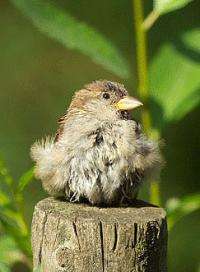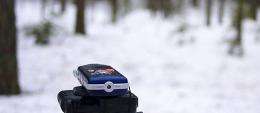In future, phones can identify the Troubadour on the tree top

In spring, the sound of birds serenading fills the air. The Department of Signal Processing and Acoustics is developing a system that can recognize a bird species based on a song segment. The system can be put to use by nature enthusiasts and biologists monitoring bird populations.
Mathematical models reveal the bird species
Researcher Seppo Fagerlund is working on a doctoral dissertation on the automatic recognition of bird species. He is constructing a system which describes bird song with mathematical models, comprising of various key figures, such as the pitch and duration of the sound.
"The main thing is to identify the key figures for which the species differ from each other. We are looking at different methods and measurements for the description of sounds and will select the ones that vary between the species", Unto K. Laine, a professor in acoustics, explains.
An unidentified song segment is turned into a mathematical model, and then compared with the models already on the database. If a match is found, the bird species has been successfully identified. The goal is for the finished system to make this identification totally automatically.
Bird spotting with a smartphone?
The system can be developed into a smartphone application. Fagerlund hopes that in the future a bird watcher will easily identify the bird twittering outside the summer cottage with a phone.
"We are still a long way off a finished service. One challenge is, for example, how phone microphones will capture birdsong all the way from the tree top", says Fagerlund.
Tool for monitoring bird populations
With the system, different species can be identified in a single recording, making it possible for biologists to find out which species visit, for example, a particular opening in the woods. On the other hand, the song of an individual bird species can be searched for in different recordings to establish the recording locations where that particular species has been present.
"If the number of birds decreases it can be an indicator of an environmental problem, such as a polluted waterway. When problems are detected at an early stage steps can be taken to protect endangered species. One of the main goals for the system is to ensure biodiversity", Fagerlund explains.

Birds sing in dialects
The identification of bird species is not a simple task because individuals in each species have a wide repertoire of sounds used in different situations. Differences between individuals also exist: two males may introduce variations into their song during courtship display, when competing for female attention. The male with the lung capacity for the longest and most complex tune is the most attractive suitor.
There are also regional differences.
"Birds have dialects, too! Birds of the same species sing differently in opposite sides of Finland. Possibly the habitat influences birdsong, or then the populations in different regions are diverging into separate subspecies", Laine speculates.
Despite the variations, birds understand each other. It is not out of question that humans could also learn to understand bird communication.
"My dream would be to compile an avian grammar or songbook that we could use to recognise and imitate different bird signals. In principle, it might be possible by collecting and classifying adequate statistical material on various bird sounds and by analysing song structures", Laine visualises.
Signal processing as a tool in bioacoustics
Bioacoustics studies the sound-based communication of different animal species. During the last decade, sound processing technology has come on in leaps and bounds, which has spurred research in the field.
Researchers in signal processing design methods and technology for classifying sounds. The role of signal processing in bioacoustics is to develop techniques for reducing atmospheric static and other disturbances in recordings and for separating and identifying the sources of sound.
Provided by Aalto University
















